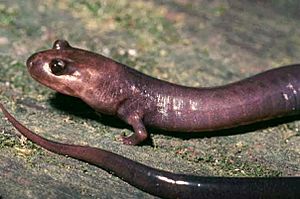Red Hills salamander facts for kids
Quick facts for kids Red Hills salamander |
|
|---|---|
 |
|
| Conservation status | |
| Scientific classification |
The Red Hills salamander (Phaeognathus hubrichti) is a fairly large salamander that lives on land. It can grow to be about 255 millimetres (10.0 in) long. This salamander has a gray to brownish body with no special markings. Its legs are quite short.
This unique animal is the official state amphibian of Alabama. It is endemic to Alabama, which means it is found naturally only in that state. The Red Hills salamander is the only species in its group, called Phaeognathus.
Contents
Where Do Red Hills Salamanders Live?
The Red Hills salamander lives in a small area in southern Alabama. This area is about 60 miles (97 km) long from east to west and 10 miles (16 km) to 25 miles (40 km) wide from north to south. It is found within a special region called the Red Hills.
This salamander's home is limited by two rivers: the Conecuh River to the east and the Alabama River to the west. Scientists have found these salamanders in several counties, including Butler, Conecuh, Covington, Crenshaw, and Monroe.
What Does Their Habitat Look Like?
Red Hills salamanders make their homes in burrows on the sides of moist, cool valleys. These valleys are often shaded by tall hardwood trees. The ground in these areas has a special layer of siltstone rock. This rock has many cracks and tunnels that the salamanders use.
The topsoil where they live is usually sandy. This type of soil and the underground tunnels provide the perfect environment for these salamanders to thrive.
Why Is the Red Hills Salamander Endangered?
The Red Hills salamander is considered a threatened species. This means its future is at risk. There are several reasons why this salamander is in danger. Its home range is very small, and it is losing its habitat. Also, these salamanders do not have many babies, and they cannot travel far to find new homes.
How Does Habitat Loss Affect Them?
About 60 percent of the remaining salamander habitat is owned by paper companies. These companies often use a method called "clear-cutting" to harvest trees. Clear-cutting means all the trees in an area are cut down. This method, especially when followed by preparing the land for new trees, can completely destroy the salamander's home.
However, Red Hills salamanders prefer areas with hardwood trees, not pine trees. Clear-cutting is mostly used for pine forests. So, while clear-cutting is a threat, the salamanders' preferred hardwood areas are less affected by this specific method. Still, any loss of their unique habitat is a big problem.
Protecting Their Home
Organizations like NatureServe consider the Red Hills salamander "Imperiled," which means it is in great danger. To help protect them, The Nature Conservancy bought about 1,786 acres (7.23 km2) of land in 2010. This land will help provide enough habitat for the salamanders to survive.
This land will eventually be given to the state of Alabama for people to enjoy. By 2020, over 11,000 acres (45 km2) of land in the Red Hills area was protected. This is a big step towards saving this special amphibian.
What Are the Biggest Threats to the Red Hills Salamander?
The Red Hills salamander faces many challenges that threaten its home and future. It is a unique and critically endangered amphibian.
Losing Their Home
The Red Hills salamander is losing its habitat because of several activities. These include cutting down trees, changing their moist valleys into pine tree farms, and clearing the tops of hills above their homes. These actions either destroy or harm the places where they live.
Most of the salamander's habitat is on private land owned by timber companies. Even though some improvements have been made through special agreements, harmful forestry practices still happen. Also, wild pigs can cause problems in some areas by disturbing the habitat.
Dangerous Diseases
A new disease threat for the Red Hills salamander is a fungus called the salamander chytrid fungus (Batrachochytrium salamandrivorans, or "Bsal"). This fungus has caused many European fire salamanders to die since 2008. It might have spread through the international pet trade.
Even though Bsal has not been found in the Americas yet, its fast spread in Europe is a big worry. If Bsal comes to the United States, it could severely harm salamander populations, including the Red Hills salamander. It is very important to take steps right away to protect these animals from this potential threat.
Images for kids




